Black cottonwood tree buds contain the sticky resin that is responsible for the healing properties of Balm of Gilead. The resin is the sap from the cottonwood tree or balsam poplar. Learn to harvest the buds and use them to make Balm of Gilead oil and salve. Balm of Gilead salve is anti-inflammatory, and pain relieving and traditionally used for sore joints and muscles.
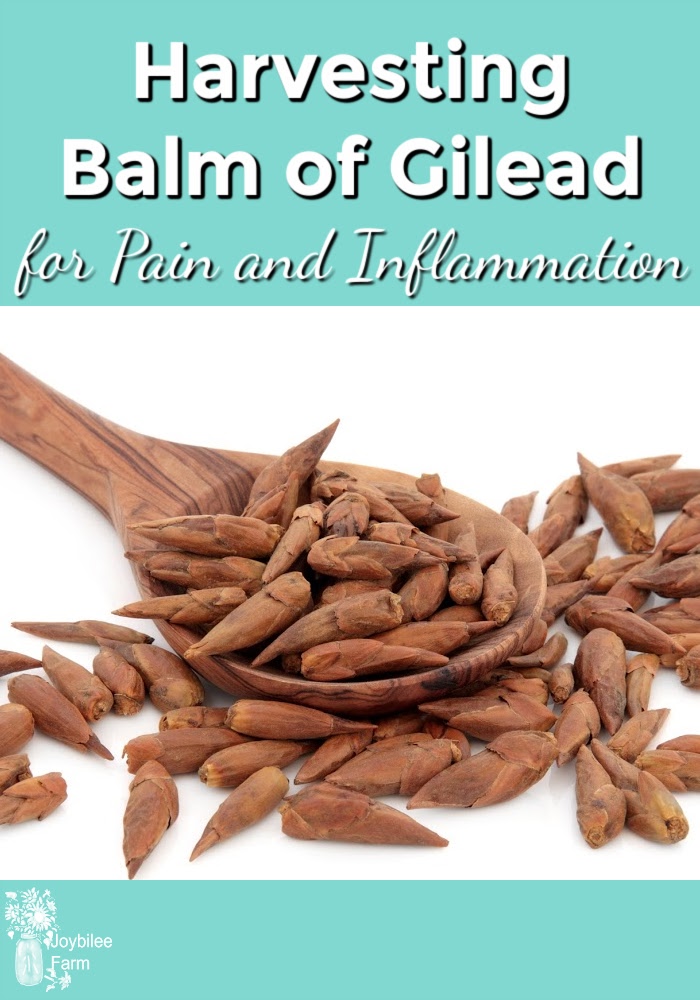
Harvesting Balm of Gilead
Around Joybilee Farm one of the first signs of spring is the pleasant fragrance of the wind in the cottonwood trees. It fills the air with a joyous perfume and announces the season for the harvest of the spring buds needed for Balm of Gilead ointment. In the late spring, you’ll know if you have cottonwoods growing near you, by the abundant white, cottony fluff that lines the lanes and pathways and floats through the air. But don’t wait for the fluff before you start looking for cottonwood buds or you’ll miss out. These are not the only spring buds that can be used for herbal remedies either!
Balm of Gilead comes from the early spring buds of the Balsam Poplar (Populus balsamifera), the Black Cottonwood (Populus trichocarpa) or the Narrowleaf Balsam Poplar (Populus Angustifolia). There are several other cottonwoods and poplars native to North America but only these 3 produce the balsam buds and characteristic medicinal scent of balm of Gilead.
This post is about harvesting and using the spring buds of the Black Cottonwood, native to BC, Canada, and the Western USA. You can use the information gleaned here to help you identify and harvest buds from the correct species that grows near you. These three species of balsam tree will cross-pollinate where their territories overlap and produce hybrids like Populus x jackii, that are also suitable for Balm of Gilead herbal use.
The balsam of mecca or balm of Gilead tree mentioned in the Bible in Genesis 37:25 and in Jeremiah 8:22, Jeremiah 46:11, Jeremiah 51:8 is a different tree than the tree referred to here. The balm tree found in Israel (Commiphora gileadensis) and the Middle East is from the cork wood family and exudes a resin, much like pine, myrrh and frankincense, that is used in perfumery, incense, aromatherapy, and herbal medicine. In the story of Joseph, Jacob, the patriarch of Israel, sent balm of Gilead salve to Egypt with Joseph’s brothers, as a gift to the ruler, when asking for food during the famine recorded in Genesis. In Jeremiah, it is reputed to heal pain and the prophet asks Judah, “Is there no balm in Gilead?” In the bible the balm of Gilead was a cure-all. Many herbalists in North America view cotton wood balm in a similar light.
The tree that that we are using is from the poplar family. It is the spring cottonwood buds that are used in medicine and perfumery. However in both cases the resin that the trees produce, has healing properties, eases pain, and is used in first aid salves.
Make positive identification of the cottonwood tree
To determine if the balsam tree, cottonwood or poplar trees growing near you are the right kind, touch and smell the young leaf-buds, before leaf break. The egg-shaped buds smell strongly of a pleasant perfume, with a hint of camphor. The buds will be sticky and resinous, coating your fingers with reddish brown gum. The young branch tips will be deeply coloured with the rising sap.
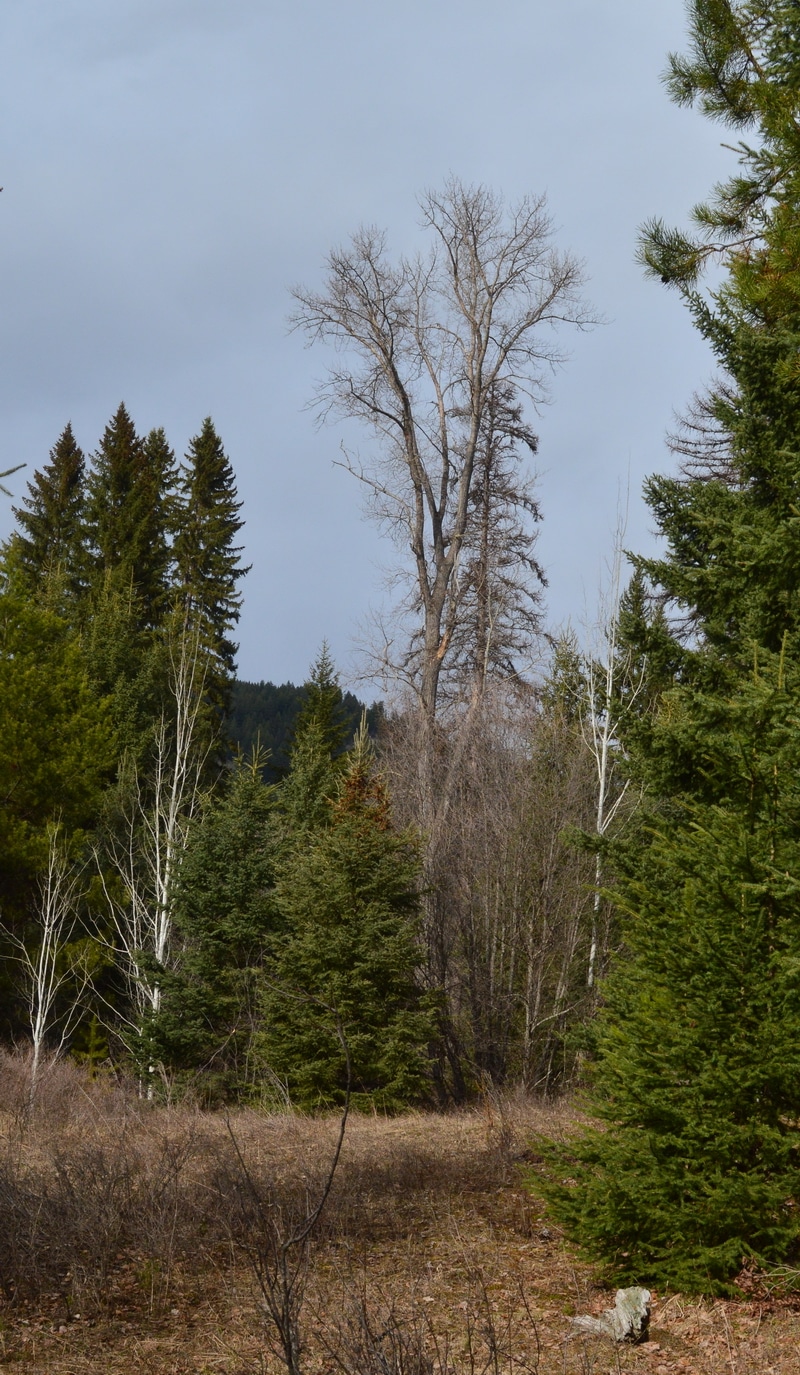
A mature cottonwood before leafing out in Spring
You’ll find these cottonwoods near water in a riparian habitat or where the habitat contains underground springs. Cottonwoods are tall trees and will stand out in the forest, surrounded by shorter pines, spruce, and birch. Often other fast growing, water-loving species will be growing nearby such as aspen and alder. These pictures are of the Black Cottonwood, native to Western North America. The bark of the trunk of a mature Black Cottonwood tree is grey and deeply fissured.
The root system is shallow and wide spreading. The wood is corky and not strong. Branches often break off in a windstorm and in spring a strong wind can blow over an old tree. After a wind storm you may find branches loaded with unopened buds lying on the ground under mature cottonwoods.
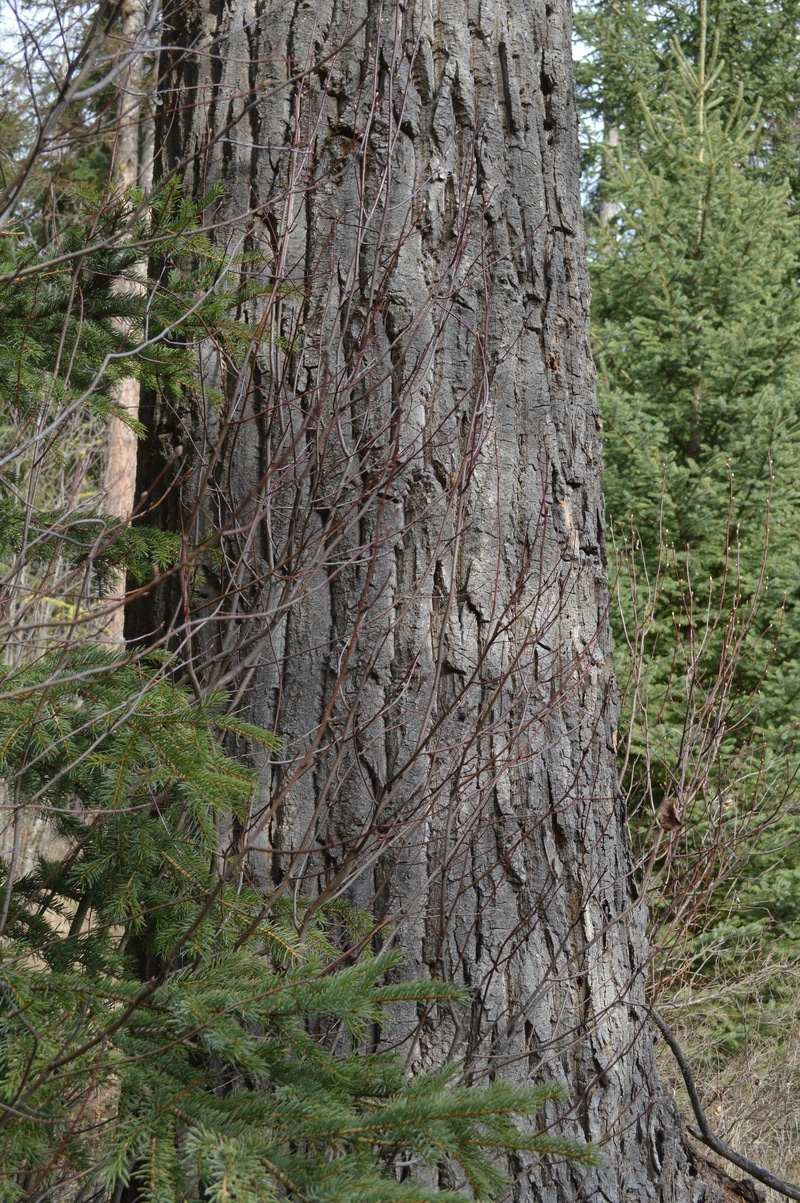
The deeply fissured trunk of a mature cottonwood poplar.
The young tree bark is grayish green with prominent lenticels, similar to birch. The young growth changes colours to bright reddish brown as the sap rises in spring. The mature tree can be up to 30 meters (100 feet) tall and has a distinctive silhouette in the spring landscape. If you are looking for a tree in the summer, it will be fully leafed out. The leaves are dark green, long, and sometimes heart-shaped. On the underside of the leaf, there is often a splotch of the reddish-brown resin still evident.
The cottonwood trees are prone to wind damage and a windfall branch in winter or early spring can yield an abundance of resinous buds. If you find such a treasure, be sure to harvest every single bud. On the other hand, usually, the tree is too tall to allow you to harvest from a mature tree, and those looking for this herbal treasure will be searching for young saplings between 2 feet and 10 feet tall. At this height the trunk is supple and the branches can be bent over to bring the buds within easy picking range.
I’m told that the First Nations people in British Columbia tap the mature cottonwood trees to gather the resinous healing sap, but I haven’t had personal experience with this way to harvest Balm of Gilead. I’d love to learn more about this practice. If you’ve done this yourself or watched the elders do it I’d love it if you’d leave a comment and tell me your experience.
Conscientiously harvesting Balm of Gilead Buds
The cottonwood buds contain the sticky resin that is responsible for the healing properties of Balm of Gilead. The resin is the sap from the tree. If you wait another week or two, these buds will swell with the resin and then the leaves will unfold. Once the leaves break the window for the harvest season is over.
The ideal time to harvest these buds is early spring, as the snow is receding but where there are still night time frosts. If you are smelling the poplar buds on the wind, then you should look at higher elevations. Once you can smell them the sap is evaporating on the open leaves and the season has passed, but there might still be unopened buds higher up.
Since the buds represent the leaves of the tree, you want to leave enough buds on the plant to nourish the root for another season and produce the next spring’s leaf buds. The leaf buds grow during the summer months and then lie dormant on the tree from leaf drop until they swell with the rising sap, the following spring.
A general rule for harvesting cottonwood balm buds is to never take the terminal bud, which is the primary growing point at the top of the stem, as this bud represents the growing branches, as well as the future leaves. Of the buds that alternate along the branch, take only a 1/3rd. Don’t harvest from a tree that has already been harvested from – including those buds eaten by ungulates. Overharvest will kill the young trees.
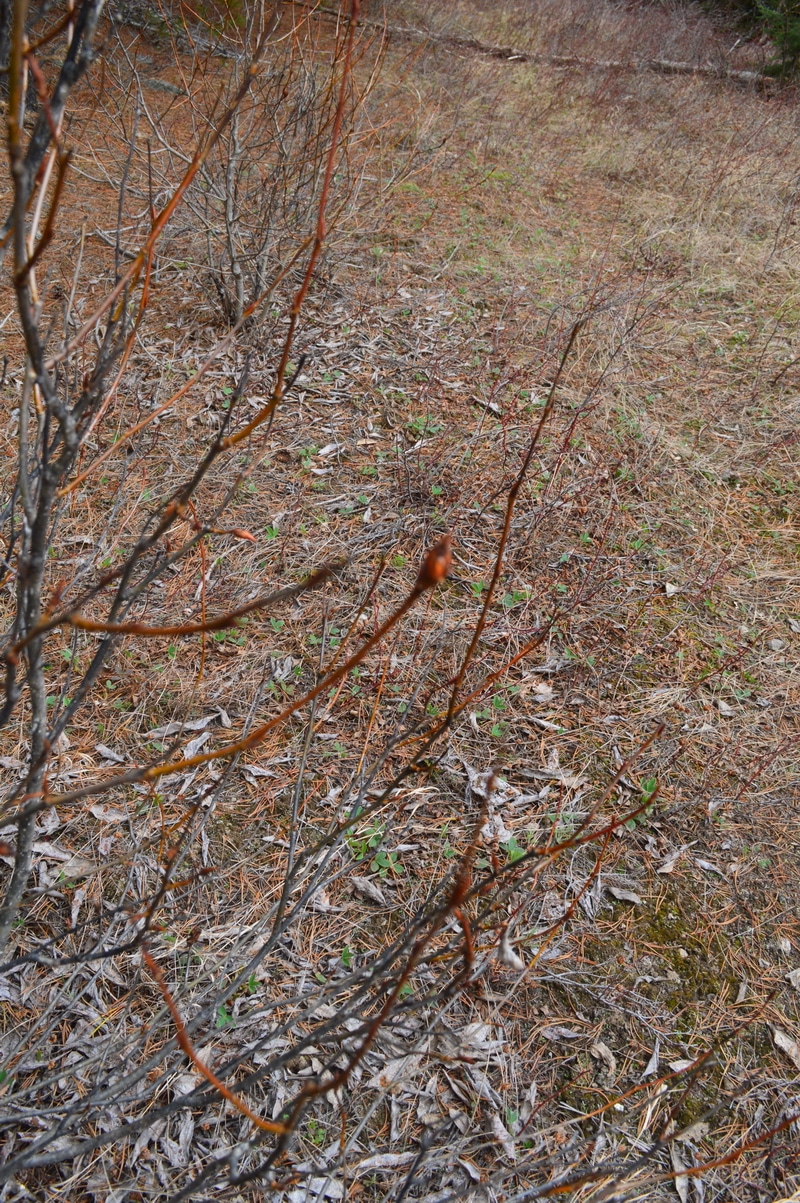
The resinous buds of the black cottonwood. The buds are “Balm of Gilead.”
General rules for harvesting buds from a black cottonwood
- Only harvest on land that you own or land where you have permission to harvest.
- Make positive identification of the tree.
- Don’t take more than 1/3rd of the buds.
- Don’t take the terminal tip on any branch.
- Respect the growth needs of the tree.
- Use what you take.
What you will need to harvest
When you go to gather in Balm of Gilead buds, you will need a basket or container to gather in our harvest. Don’t plan to put it in a handkerchief or hat, as the resinous buds will stain the cloth. A plastic yogurt container that you add a handle to, is lightweight and will more easily be cleaned than cloth.
You just use your fingers to harvest and pinch off the buds, using your hands makes it less likely that you will damage the bark of the tree.
How to deal with sticky fingers during the harvest
Harvesting resinous buds will leave your finger coated in the reddish-brown resin. You can minimize the discomfort of sticky fingers right in the field. Growing in close vicinity to the Balsam poplar and cottonwood trees are Trembling Aspens (Populus tremuloides). Look for the white yeasty powder on the smooth bark of the Trembling Aspen. When you rub your hands on the bark of the tree, the white powder covers the resin on your fingers, removing the stickiness, so you can keep picking.
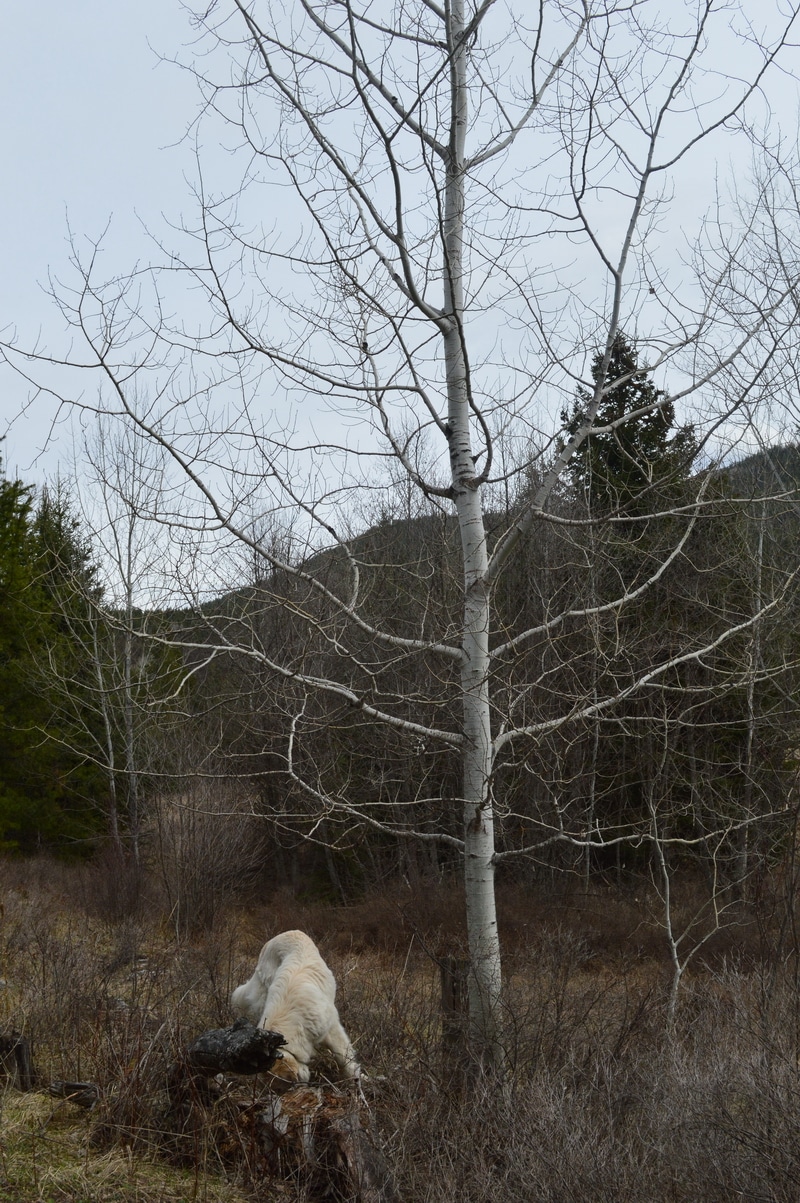
When your fingers are sticky from picking the spring buds of balsam poplar or cottonwood, look for the Trembling Aspens.
Making Balm of Gilead infused oil
Expect a meagre bud harvest unless you have a huge plantation of Cottonwood trees. Be sure to use whatever you do harvest, fully.
- For 1 cup or less of buds, place the buds in a wide mouth pint size mason jar. If you have two cups to 4 cups of buds, use a wide mouth quart jar.
- Fill the jar to within 1 inch of the top with olive oil.
- Put the jar in a warm spot. I put my jars in a sunny window where the warmth of the sun helps the buds to release their resin.
- Over a month or so, the resin will slowly move into the oil, giving the golden oil a deep reddish hue.
- Shake the jar to distribute the resin, a few times a week, while you are waiting. The oil will take on the pleasant, Balm of Gilead perfume.
After a month of jar shaking, strain the oil into a clean, brown or blue coloured glass bottle. Cap the jar tightly and label it with the date and contents, “Balm of Gilead.” You can discard the spent buds in the compost pile.
Optionally, add a ½ teaspoon of natural source vitamin E oil to your final bottle of Balm of Gilead infused oil to protect the oil from rancidity. If you keep it tightly capped and store it in a cool dry place, your harvest should last 4+ years
Making Balm of Gilead Ointment
Balm of Gilead oil is like gold around here. Since it is harvested by hand, you can’t buy it. As far as I’ve seen, the buds aren’t available in any herbal store, so if you don’t know someone who makes it or harvest your own, you are out of luck.
It takes hours to harvest a small number of buds, and while the harvest is a pleasant experience, no one does it to make money. Knowing this, you will want to treat your harvest well so that you don’t lose a single, precious drop of this healing oil.
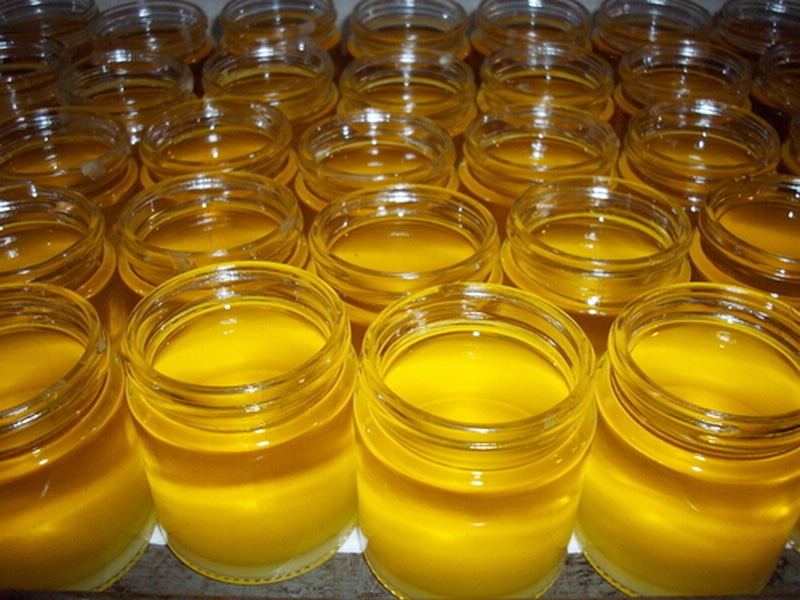
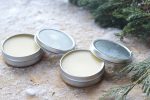
Balm of Gilead Ointment
- Prep Time: 5 minutes
- Cook Time: 20 minutes
- Total Time: 25 minutes
- Yield: 4 ounces 1x
- Category: Herbal Remedy
Description
Balm of Gilead salve is anti-inflammatory, and pain relieving and traditionally used for sore joints and muscles.
Instructions
- Make a double boiler using a glass measuring cup. (See the directions here)
- Add balm of Gilead infused oil and beeswax to the glass measuring cup.
- Heat until the mixture is blended and the beeswax is fully melted. Don’t allow it to simmer though. Keep it just warm enough to make everything liquid.
- Pour into two 2 oz. glass jars or salve tins. Cool to room temperature.
- Cap tightly.
- Label and seal.
Balm of Gilead Ointment
- 1/2 cup infused Balm of Gilead oil
- 1 tablespoon (12 grams) beeswax melted
Directions:
- Make a double boiler using a glass measuring cup. (See the directions here)
- Add balm of Gilead infused oil and beeswax to the glass measuring cup.
- Heat until the mixture is blended and the beeswax is fully melted. Don’t allow it to simmer though. Keep it just warm enough to make everything liquid.
- Pour into two 2 oz. glass jars or salve tins. Cool to room temperature.
- Cap tightly.
- Label and seal.
When to use Balm of Gilead Ointment
Balm of Gilead Ointment is:
- Analgesic
- Anti-inflammatory
- Anti-bacterial
- Astringent
- Helps detoxify
- Helps heal coughs
Balm of Gilead ointment has done some miraculous feats on my homestead. It relieves pain, especially the pain from sore muscles, arthritis, and broken bones. It reduces swelling and inflammation. Balm of Gilead oil relieves pain at the nerve level, and reduces inflammation. Combined with St. Johns Wort infused oil, it can do amazing things where there are shooting pains or injuries in the joints or even broken bones. Combine Balm of Gilead with St. Johns Wort for nerve pain, and comfrey for bone healing. Balm of Gilead salve used alone or in combination with other herbs is beneficial for joint pain and stiffness, that inhibits movement. Combine it with cayenne for a warming salve that increases blood flow to joints.
True Stories about the healing efficacy of Balm of Gilead
In the summer of 2010, a friend was visiting the farm, complaining of swelling in his knee. 10 months before he had been loading a prize-winning giant pumpkin into his truck, and he didn’t see the trailer hitch. He took the hitch, full blow, onto the knee cap. The swelling and pain never abated so his normal daily walks and bike rides had to stop. He could barely walk, and spent many days in physio or icing his knee with no change in his condition.
Since my friend was a diabetic, the long injury was an ill-omen. The day before this visit to the farm, my friend said his doctor told him to put his house in order, he didn’t have long to live. Of course, I gave him some Balm of Gilead and St. John’s Wort ointment and told him to use it liberally.
I saw him a week later and he was super excited and wanting to know more about this ointment. The swelling in his knee was reduced by 90% and he had full mobility once again.
On another occasion, Mr. Joybilee was loading wood into a wheelbarrow deep in the cold of January. He slipped on the icy driveway, coming down sharply on the handle of the immovable wheelbarrow breaking some ribs. Ouch! While he was given a prescription for Tylenol with codeine to help with pain management, the Tylenol just made the ever-present pain harder to cope with, while clouding his mind, and causing constipation. You know the routine.
Constipation caused straining which caused more pain. I very gently applied Balm of Gilead oil directly to the rib cage and applied a hot flax bag to the area (hot compress). The pain abated within 30 minutes and stayed away for 4 to 6 hours. No more prescription pain killers needed. We added St. John’s Wort tincture (orally) and Balm of Gilead ointment (topically) to the routine and he found tremendous relief. Within a week, he only needed the ointment at night to help him sleep, until the ribs were healed.
Balm of Gilead can be combined with other anti-inflammatory herbs to relieve a variety of pains. When you make your herbal infused oils this summer, consider infusing Comfrey leaf, St. Johns Wort Flowers, Calendula flowers, Arnica blossoms, Dandelion blossoms, Ox-Eyed Daisy flowers, and plantain. Use these oils in combination with Balm of Gilead when making several analgesics, healing, and anti-inflammatory ointments and salves.

Balm of Gilead Materia Medica
Download the Balm of Gilead Fact Sheet (pdf)
Cautions:
Balm of Gilead contains Salicin, which converts to salicylic acid in your body. If you are allergic to aspirin, check with your doctor before using Balm of Gilead oil. If you are unsure, test it on your skin in an inconspicuous spot to make sure that you are not allergic. If you notice any heat or redness developing, don’t apply it to your skin.
As always, this is shared as a neighbour to a neighbour home remedy. Always consult your health care professional for serious medical conditions and do your own due diligence.
I hope you found this post helpful. Please share it with your friends. Thanks.
I have a FREE gift for you
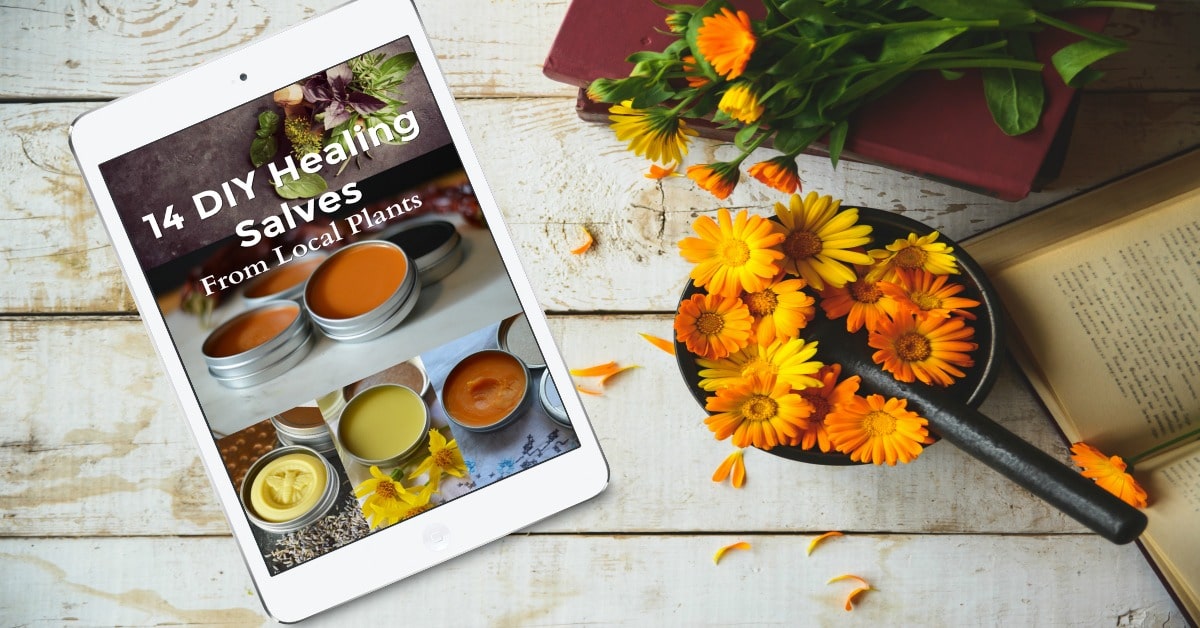
Grab my free ebook and learn to make DIY herbal healing salves at home now, with 14 easy to follow recipes that use the herbs and wild plants growing close to home. Salve making is one of the easiest skills to learn in DIY Herbalism.


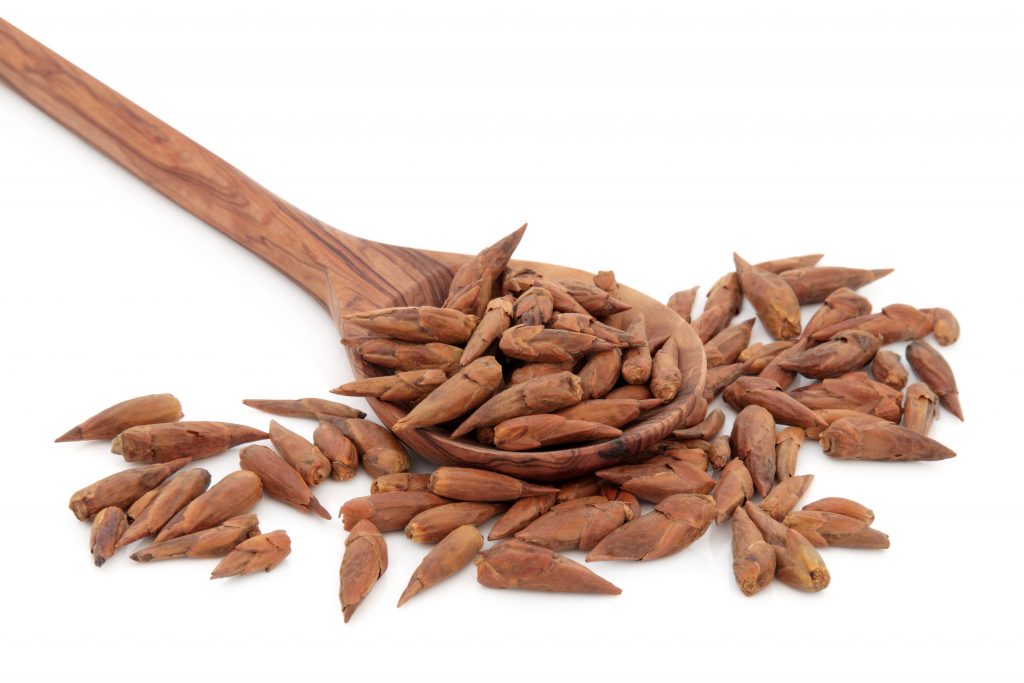

What a great post, full of needed information on harvesting! I recently heard that you could infuse your oil in the food dehydrator, which for me is much better and faster than the crockpot method, as most little crockpots are difficult to maintain the correct temperature. The food dehydrator set on 100-110 degrees does a super job. It only takes a few hours to get a nice dark oil and the longer you infuse it the more powerful the medicine. I did mine in about eight hours. The oil is ready to use. Can you then leave the buds in the oil for longer cold infusion in a dark cupboard, as long as they are submerged?
Yes, it sounds like it would work.
Hi, that was really interesting. Thank you for posting such detailed information. I really appreciate your teaching gatherers how to respect the plants and make sure we don’t harm their growth or ability to proliferate.
I am interested in Traditional Chinese Medicinal herbs and frequently use TCM herbal formulas. I’m also interested in and love plants and trees. But I know little about American herbal medicine, though long ago I read Euell Gibbons’ book, “Stalking the Wild Asparagus,” and along the way learned how to identify some edible plants as well as non-edible trees and plants. Frankly, my curiosity was piqued about Balm of Gilead when I stumbled upon online sellers of buds (I truly hope they’re harvesting sustainably). I knew nothing about B of G prior to reading your post.
Someday maybe I’ll come across a budding poplar sapling and be able to harvest 1/3 of the buds to make a salve.
Thanks again for sharing your knowledge. Best to you!
Kimi
THANK YOU for sharing your encyclopedia of information. I am a native of B.C. now living in Massachusetts and and will harvest some balsam poplar buds this Spring.
My daughter lives in the Western Kootenay region and I would love to buy her a book of wild foraging for her area, or for B.C. I would truly appreciate any suggestions you can share.
Thank you again for your time and energy that you invest in providing so much information here on your site. God Bless and keep you safe and healthy.
I have Plants of the Inland Northwest and Southern Interior British Columbia. Its still available on Amazon here: https://amzn.to/3K4sp2w
All this info is so amazing – thank you so much! I think we may live too far south (central Virginia, USA) for any of these trees. I wish there were a way to buy this somewhere. It sounds like buying the St. John’s Wort oil is a possibility. Is there a retailer/brand you’d recommend for that, at least? (Can I come do an internship at your farm for a couple weeks? ha ha. Kidding, not kidding.)
Balsam poplar grows in Virginia. Mountain Rose herbs carries St. Johns Wort infused oil.
I thoroughly enjoyed reading and learning more about B of G. When I was growng up (British Columbia) my mum would harvest buds every spring and infuse them in olive oil. When she passed away she left several jars of infused oil not yet made into a salve. These jars are 18 years old now and the oil is not rancid and smells like heaven. All these years later I am wishing I had paid more attention to how my mum found the right trees and the whole process. We have cottonwood trees here but I don’t detect that telltale aroma on them. However, my neighbor has a pussywillow tree that smells exactly like my mum’s buds. But the pussywillow buds do not have any resin. The cottonwood trees in our area have buds but I don’t see any resin – just a tiny tiny orange dot at the end of each bud. Am I picking too early? I see you get hundreds of comments – I understand if you simply can’t reply to each one. I will keep searching for info!
That tiny orange dot is the resin. The smell doesn’t come out until the buds open usually later in the spring. But you want to pick them before the buds open so that wonderful smell is in your infused oil, not dissipated into the air. Once the buds open its too late to harvest the buds.
Another method to remove resin from fingertips when picking Balsam Poplar buds is to use a few drops of hand sanitizer that we all carry these days. This is by far the best way to clean up.
I’m so happy to have found your post. I’ve been trying for years to get an old family recipe for “balmagator” salve that the elder women in my family used to make. I had heard it was good for skin ailments like eczema and psoriasis and joint ailments like arthritis. I was just up north in Michigan, hiking some state park trails and discovered the Balm of Gilead buds on trees near Lake Michigan. It was the buds that alerted us to the presence of something magical. We were watching the sun set and it was very windy, but as soon as the sun sank over the horizon, the wind died down and the grove of young Balsam Poplar all around us gave off the most heavenly scent. I was certain I had finally found what I was looking for. Now to find your blog with such helpful information is perfect timing.
Thank you, from the bottom of my heart!
I’ve been making St John’s wort and arnica infused in olive oil, with cinnamon, clove, ginger and juniper essential oils added at the end that makes a wonderful healing oil. Cannot wait to finally. be able to make what my grandmothers made…
I am experiencing “Covid arm” (red itchy swollen area at vaccine injection site.). Is Balm of Gilead a good alternative to over the counter steroid cream?
Hi, if the buds are picked a little to early will they still ripen and make a resin?
thank you,
You need to get them before they open so yes, pick early. Once they open the resin is dried up.
I live in the southeastern US and we don’t have the black cottonwood (only the Eastern cottonwood, from what I’ve read). We are trying to find Balm of Gilead oil created from something other than olive oil and have had no success with a limited search. Am I correct that the black cottonwood is the only type that will produce the effective product? I can buy the buds online, but they are dried and would seem to be of little use. Any suggestions?
Eastern cottonwood and balsam poplar should both be useable for this.
I make it with grape seed oil
thank you for all of this wonderful info, freely given – especially the part about conscietious harvesting and NOT taking terminal buds or too many leaf buds; so many people don’t know that stuff! I love your blog and will be reading more. I hope you and your family are all well and safe from the covid.
I harvested some last year. I mix coconut oil, beeswax and the infused balm of Gilead in mine.
My wife accidentally ran a power washer over her foot last summer while doing the deck.
She put balm of Gilead on it and within seconds the pain was gone. She uses it for arthritis as well with remarkable results.
The only thing that took off the stickiness last year was olive oil and vigorous rubbing. This year I will be taking a small jar of it along with an old rag and just coat my hands as I go along and clean periodically.
Good hunting to all of you out there.
Do you sell the Oil you make?
I have a dear friend who has psoriasis mainly on his upper body I’m just wondering if this would help?
Crushed Dandelion leaves on the parts where the psoriasis is help to clear that up. Crush the leaves and put it over the area’s and wrap it with something to keep it in place. Renew every 8 hours or so. Dandelion leaves also help with snake or spider bites. Especially with brown recluse spider bites. Clears and disinfects
Great article! The flowers must be highly medicinal too as the scent from them is out of this world. I’ve dried some flower stems for the last 5 years as an experiment and i still have them now! They all smell devine and the oldest ones havent lost their scent in fact they smell stronger of medicine type scents. Never made any medications with any though i have smoked some as i do with tree resins and though you dont get high or stoned boy do you feel great! The coming spring i’m going to make an oil/tincture from the flowers and try the sap and the buds also. All the best………dave, UK
excellent writing and description of the process. We just harvested 2 quarts and were not sure the best method… and like yours. Thank You, Thank you!
Hi Chris! I was traveling for a month out of state (I live in Washington & used to live in AK very close to BC & Yukon border) and missed the prime bud-picking time on the cottonwoods. However, I went today and found many fallen/cut cottonwood branches at a local park. Some had intact buds but most had buds where the leaves had broken though, but were still bud-ish and super resinous. I collected as many as I could that weren’t fully leafed out.
Do you think that if I were to try to make the oil with these partly leafed buds it would produce a negative effect from the leaves?
I could do it with just the non-leafed, but I don’t have many of those compared to the others (and they are all in a sticky mess together).
Thanks! This is my first wildcrafting experiment (besides picking berries,) so I’m excited to try regardless of if it doesn’t come out perfect.
Hi, Olive in a pinch it’s better to make medicine with what you have than to go without. I have made medicine with the buds swelled. I think if the buds are resinous and have a fine fragrance you will be fine. They might be a bit moister though than you want for a long maceration process, so I’d recommend using some heat to extract the resin more quickly. If you have a crock pot, put 4 inchs of water in it and then insert your mason jar with the oil and cottonwood buds. Turn the crock pot on low and leave it for 24 to 48 hours. By speeding up the process with some heat you should avoid any mold issues. Be sure to preserve it with vitamin e when you are done.
Ooh! I nearly missed your reply! Good thing I checked back, because I’ve had the jars of buds & oil sitting out for about five days now. They still smell okay, so I will crock pot them now. Thanks for your wonderful advice! I will let you know how it turns out. 🙂
The oil is completed! Not a deep red, but faintly red and definitely darker and cloudier than the original oil and it does have the perfumed scent to it. Now, with this trial under my belt, I can be better prepared next year and still enjoy the lovely scent and some homemade balms even if they aren’t as medicinal as a properly made oil would have created.
Thanks again for your guidance!
I’m glad it turned out for you. I just harvested my own balm of gilead buds and like yours they were close to opening. I had to use the heat method on mine. I may leave them in the jars and reheat a few times before straining. It’s just heavenly being under the trees and breathing in that scent.
This spring has been way earlier than usual. I’m a month early with my picking of the buds.
We have in our area a grove of ancient balm of Gilead trees, planted by pioneers traveling through… Elev. 9000+/-
Some trees are 100 ft. Tall. Don’t know why this grove was planted in such an unlikely area and altitude.
Have not accurately identified this tree yet…the phenomena I am inquiring about is: from the dead decaying trees, wind falls beaver falls, lightening strikes, new trees are growing…does this happen on your trees?
Thank you.
That’s very interesting. I haven’t encountered that.
That’s the only photo we didn’t get…my batteries were both dead and the other gal just didn’t get that….those trees have been in that grove since at least 1776 as Domingez and Escakante named the area Balm if Gilead Park.
There us a sign reflecting when they went through the area
Where do you live? In Colorado? I have a sister in Kansas
that is interested in finding this park and see the ancient
trees. I live in Minnesota and am researching areas here
where I can harvest buds.
when you say to use st. john’s wort oil with balm of gilead, do i combine both oils together when making this ointment ..
if so how much oil (st. john’s wort) do i add to the balm of gilead ointment i am making and does the quantity of the other ingredients in the balm of gilead change.
today i have started 3 pint jars of buds with olive oil, so anxious to make this ointment in one month .. Rolande
Rolande, this post has recipes that you can adapt –
This is quite a tedious process but you have explained it so well. Please let me know how to place an order for balm of Gilead.
Thank you for another wonderful post!
Do you know Beverley Gray’s book, THE BOREAL HERBAL, Wild Food and Medicine Plants of the North. A Guide to Parvesting, Preserving, and Preparing? It’s an excellent book and she’s a fabulous teacher. The book is a good read as well as an excellent reference. Bev lives in the southern Yukon and I live in the central Yukon, but I find that most of the book is applicable even in Oregon where my parents live. The Black Cottonwood and Balsam Poplar connection is a great example. We don’t have Black Cottonwood here, but they do and we have Balsam Poplar. I didn’t know those two were related. Thank you for that information, I will pass it on to my parents. Our buds will probably be ready to harvest in about 2 weeks. I’m ready for sticky fingers!
Thanks for the recommendation of another great herbal book to check out. I’ll see if I can find it at the interlibrary loan system here in BC. I’d love to read it.
Do you make this for purchasing! I’m not sure if I would be getting the best product Any suggestions?
We don’t sell herbs.
This is the first year of making a cottonwood bud salve (you call it Balm of Gilead oil) – I am 55yo with arthritis in my hands, osteoporosis, and a bulging disc in my lower back (constant pain source). Working on a large ranch means I have previously had to take vicodin almost daily to be able to walk upright, especially after a day of raking and spring cleaning chores outside. I read an article about the bud salve last winter, and since I could only find one source to buy it online (and it was VERY expensive!) decided to make a batch myself this spring to try – and so far I haven’t found a single ache or pain that it hasn’t helped …. including hemorroids! I made just enough to send a small jar to all my family and friends, and now I’m making a second larger batch so I will have lots on hand for anyone who wants to give it a try. I wish I had previously known about adding St. Johns Wort oil for nerve pain, but will be sure to get some before this last batch is finished so I can try that out on sciatic nerve pain (the type that goes from your butt down legs). Great post!
I’ve used St. Johns Wort tincture for severe sciatica pain — the kind that Tylenol 3 doesn’t touch but makes you feel groggy anyway. I didn’t need a single Tylenol after I took St. Johns Wort and the pain had vanished in two days without any other intervention. That is enough to motivate me to get out there and pick those pretty yellow flowers in mid July.
Great post, thanks a lot. I live in CA and would like very much your advise how to hey those buds to get the oil for my lower pack pain.o really would like to try it. You say that you don’t sell it, neither the stores. What’s your avise for my bank pain. Thanks a million for your wonderful post
Maria, search on Etsy for “Balm of Gilead” salve. There are many artisans making it and selling it there.
You need the balm of gilead and you may want to add fermented foods like sauerkraut & homemade fermented vegetables etc for the lactobacillus. It’s the good bacteria that our systems have lost since the invention of antibiotics. All the best!